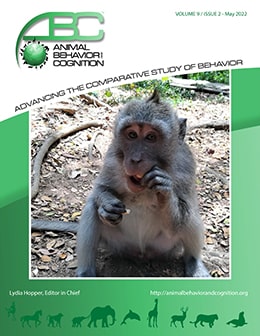Vol 9, Issue 2, May 2022
Great Tits Chosen for Greatness Makes Them Representative: A commentary on Farrar et al.'s "Replications, Comparisons, Sampling and the Problem of Representativeness in Animal Cognition Research"
Citation
Isaksson, E., Urhan, A. U., & Brodin, A. (2022). Great Tits Chosen for Greatness Makes Them Representative: A commentary on Farrar et al.'s "Replications, Comparisons, Sampling and the Problem of Representativeness in Animal Cognition Research." Animal Behavior and Cognition, 9(2), 217-221. https://doi.org/10.26451/abc.09.02.06.2022
Abstract
Studies of animal cognition struggle frequently with the question of how representative results from small samples are for a species. A recent article by Farrar et al. (2021), in this journal, highlights some of the major problems and suggests some solutions to these with cautionary examples drawn from the animal cognition literature. One such example comes from a study of inhibitory control in the great tit, Parus major, by the authors of this commentary. Although we recognize, and agree, that there are issues regarding representativeness in studies of animal cognition, we disagree with the use of our inhibitory control study as a cautionary example. Here, we explain why we think that our study is representative of Great tit inhibitory control. In fact, some of our arguments as to why our study is representative are in agreement with suggestions by Farrar et al (2021), e.g., comparing individuals with different levels of previous experiences in the cognitive paradigm under investigation. Moreover, we also add to Farrar et al.’s (2021) conclusion on how to approach studies with ambiguous representativeness by highlighting the importance of recognizing and discussing methodological differences in studies of cognitive ability. In summary, we do not argue against the valid points laid out by Farrar et al (2021), but discuss important nuances of the representativeness issue to also consider and, most importantly, add an additional point of scrutiny to account for in comparative animal cognition research.
